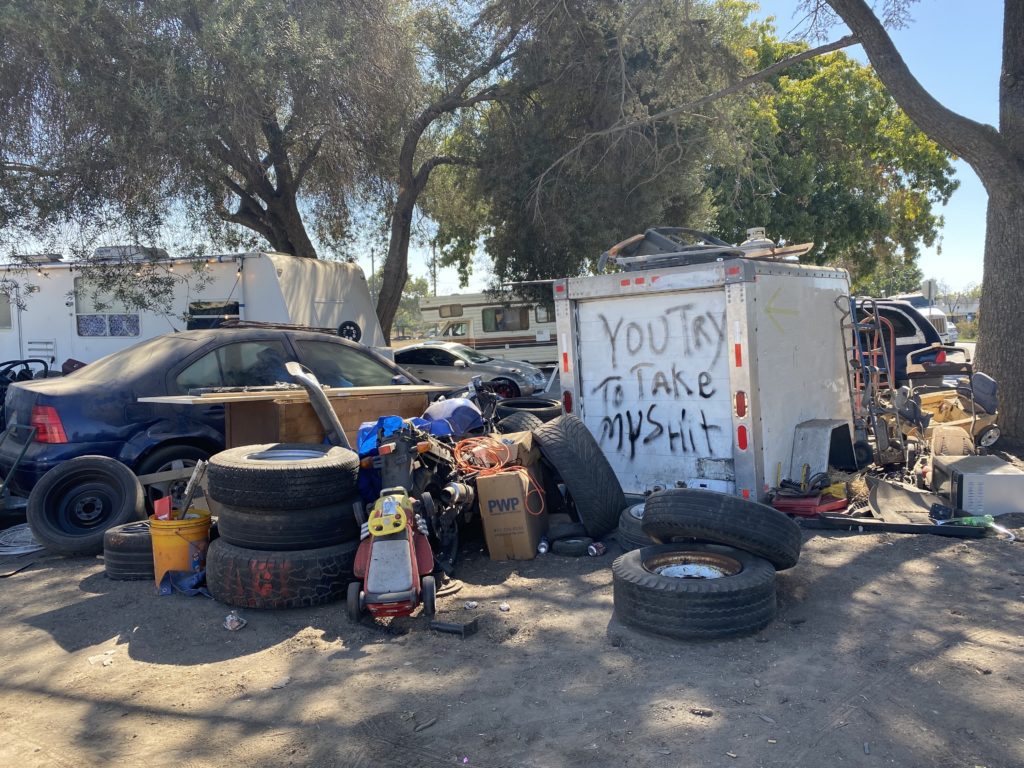San Jose residents and elected officials are frustrated with the buildup of more than 200 homeless encampments. The city plans to clean up some of them by next spring.
The San Jose City Council reviewed the city’s ongoing encampment management policy on Tuesday. City officials will come back with a plan to identify encampments across the city for increased trash service. BeautifySJ, the city’s cleanup program, plans to add 28 positions in order to increase the frequency of trash services to once a week at encampments—up from every two weeks.
Councilmembers will hear about BeautifySJ’s hiring efforts in January.
In June, San Jose approved $14 million to clean homeless encampments to counter the rising amount of encampments during the COVID-19 pandemic. Now it’s planning to invest more time and effort cleaning and controlling where unhoused residents stay.
According to officials, the city removed more than 3.2 million pounds of trash at encampments over the past year.
“A big part of what we’re trying to do is build a trash service for thousands of people that have no address,” said Jon Cicirelli, director of the city’s parks department. “It’s complicated.”
City officials implemented a 150-foot “buffer zone” around schools in April that notified unhoused residents where encampments could be located. San Jose may expand buffer zones to block off areas near city playgrounds, mobile home communities, residential areas near city property and hospitals pending another update next year. Areas near waterways also are under consideration.
The city swept 18 homeless camps inside school buffer zones between May and August. San Jose led or participated in at least 97 abatements between October 2020 and April, according to city documents.
Fearing encampments encroaching on public places like schools and clinics, councilmembers offered solutions, including monitoring city job vacancies that work with encampments and considering where encampments should be prohibited.
“None of this that you’re talking about is possible unless we have the staff to do it,” said Councilmember Raul Peralez. “We know this is extremely impactful for those individuals in our community who are out there unhoused experiencing this trauma, but also for those doing this work. This is not easy work.”
Keeping things clean
San Jose has employed various methods to combat the homeless crisis, from expanding safe parking sites to tripling the number of emergency housing units in the city by December 2022. The city turned down sanctioned encampments earlier this year, which would have designated certain places around the city for unhoused residents. San Jose also expanded a homeless trash-picking program last month, doubling the number of unhoused workers in the program to 100.
BeautifySJ, Goodwill and San Jose Resiliency Corps have been working to pick up trash from encampments every two weeks. Since the year began, the city has fluctuated from its low of 208 encampments from April to June to its current peak of approximately 220 encampments.
Some unhoused residents and activists are dissatisfied with the city’s encampment procedures. In August, a South San Jose encampment was found to be without adequate trash service from the city. Near downtown, an encampment within the flight path of Mineta San Jose International Airport will be removed by April 2022 under orders by the Federal Aviation Administration (FAA), leaving residents searching for answers.
“There’s over 250 people living there, close together, on top of each other,” said homeless activist Gail Osmer. “There’s bile and waste all over the place. There’s trash all over the place. No one is doing anything about it. You knew this was coming and you chose to ignore it.”

Part of the city’s approach to countering homelessness might include hiring people from the San Jose Bridge program, which employs unhoused residents to pick up trash. Some councilmembers want to expand the city’s encampment clearing policies to include removing vehicles and RVs from encampments within buffer zones—as well as wanting collaboration with outside public agencies to help in clearing efforts.
“I have high expectations in terms of interagency cooperation,” Vice Mayor Chappie Jones said. “I think it’s something we need to continue to push.”
City officials will return to the council in April with further recommendations on managing encampments and relocation. The city is up against an FAA deadline to move the unhoused residents in the “crash zone” at Guadalupe River Park to meet federal requirements and avoid losing millions in funding.
“It’s a traumatic experience, and these are people who are already suffering trauma. These are people already in crisis,” Cicirelli said. “We don’t take these decisions lightly.”
Contact Lloyd Alaban at [email protected] or follow @lloydalaban on Twitter.



Leave a Reply
You must be logged in to post a comment.